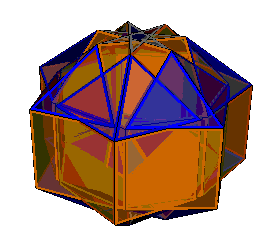
Elongated Spheno-prisms
Spheno-prisms can be elongated by the insertion of an equatorial belt of squares or gyro-elongated by the insertion of an equatorial belt of triangles. For the purpose of this page, I refer to the former of these belts as a "square cingulum" and the latter (triangular belt) as a "cingulum" from the Johnson Solid disphenocingulum, although I do not limit my use of the term to belts of precisely 12 triangles. As neither family can be broken down into polyhedral pieces then these two families must also be treated as being elemental convex prisms.
The Elongated Spheno-prisms can be regarded as the two hemispheres of the equivalent Spheno-prism separated by a square cingulum of 3n squares which wraps around the prismatic symmetry axis d times. The family remains 3-uniform. The base n/d-gon remains surrounded by (type A) vertices of the form n/d.4.3.3.4 as in the Spheno-prisms.Type (B) vertices are now of the form 3.3.4.4 and type (C) vertices of the form 4.4.4.3. The above image of a semi-transparent 7/3 Elongated Spheno-prism appears typical of this family. A model with one Spheno-prism cap removed shows clearly the structure of the square cingulum.
A full list of the locally convex members of this
family for d>1 and n<=12 is given below.
| 5/2
Cutaway |
7/3
Cutaway |
8/3
Cutaway |
9/4
Cutaway |
11/4
Cutaway |
11/5
Cutaway |
12/5
Cutaway |
Next: Gyro-Elongated Spheno-prisms
Back:
To Prisms
Back: To Index